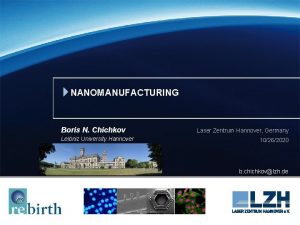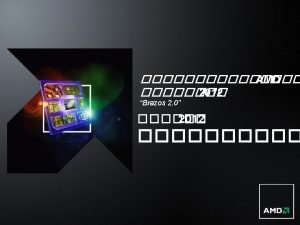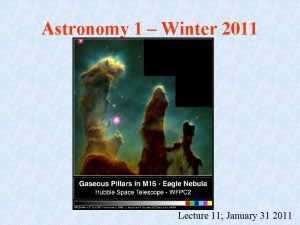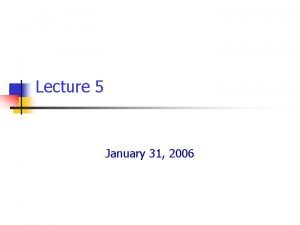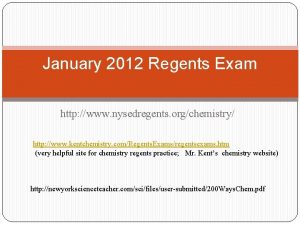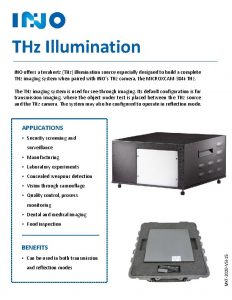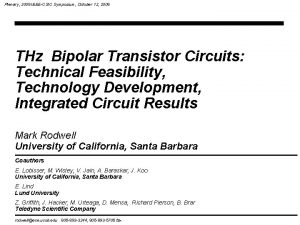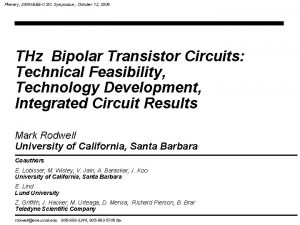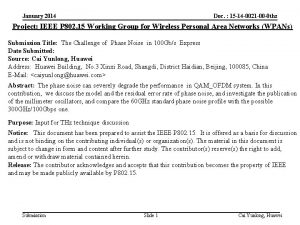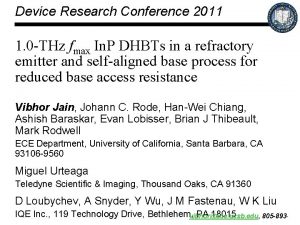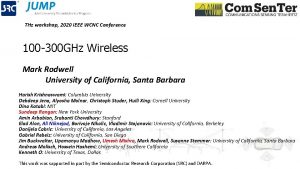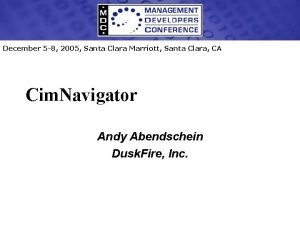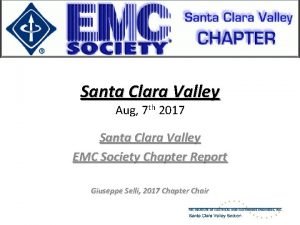PCSI Conference January 15 2008 Santa Fe THz



































- Slides: 35

PCSI Conference, January 15, 2008, Santa Fe THz & nm Transistor Electronics: It's All About The Interfaces. M. Rodwell, Art Gossard University of California, Santa Barbara Collaborators (III-V MOS) A. Gossard, S. Stemmer, C. Van de Walle University of California Santa Barbara C. Palmstrøm, University of Minnesota P. Asbeck, A. Kummel, Y. Taur, University of California San Diego M. Fischetti University of Massachusetts Amherst J. Harris, P. Mc. Intyre, Stanford University rodwell@ece. ucsb. edu 805 -893 -3244, 805 -893 -5705 fax

Tera. Hertz and nano. Meter Electron Devices How do we make very fast electron devices ? . . . by scaling What are the limits to scaling ? attainable contact resistivities, attainable thermal resistivities attainable contact stabilities and for FETs, attainable capacitance densities How can the materials growth community help ? work on interfaces (contacts and gate dielectrics) ! Guidance of utility of other device structures / features nanowire pillar devices access resistances & capacitances relevance and irrelevance of mobility

THz & nm Semiconductor Device Design. . . is scaling

Frequency Limits and Scaling Laws of (most) Electron Devices PIN photodiode To double bandwidth, reduce thicknesses 2: 1 reduce width 4: 1, keep constant length current density has increased 4: 1

applies to almost all semiconductor devices: transistors: BJTs & HBTs, MOSFETS & HEMTs, Schottky diodes, photo mixers, RTDs, . . . high current density, low resistivity contacts, epitaxial & lithographic scaling FETs only: high ereo/D dielectrics THz semiconductor devices

Why aren't semiconductor lasers R/C/t limited ? high er dielectric waveguide mode confines AC field away from resistive bulk and contact regions. AC signal is not coupled through electrical contacts dielectric mode confinement is harder at lower frequencies

Bipolar Transistor Design

Bipolar Transistor Design is Simple


HBT scaling laws Goal: double transistor bandwidth when used in any circuit → keep constant all resistances, voltages, currents → reduce 2: 1 all capacitances and all transport delays → thin base ~1. 414: 1 → thin collector 2: 1 → reduce junction areas 4: 1 → reduce emitter contact resistivity 4: 1 (current remains constant, as desired ) need to reduce junction areas 4: 1 reduce widths 2: 1 & reduce length 2: 1 → doubles DT reducing widths 4: 1, keep constant length→ small DT increase → reduce base contact resistivity 4: 1 reduce widths 2: 1 & reduce length 2: 1 → constant Rbb ✓ reducing widths 4: 1, keep constant length → reduced Rbb Linewidths scale as the inverse square of bandwidth because thermal constraints dominate. ✓✓ ✓

Bipolar Transistor Scaling Laws Changes required to double transistor bandwidth: parameter collector depletion layer thickness base thickness emitter junction width collector junction width emitter contact resistance current density base contact resistivity change decrease 2: 1 decrease 1. 414: 1 decrease 4: 1 increase 4: 1 decrease 4: 1 Linewidths scale as the inverse square of bandwidth because thermal constraints dominate.

Status of Bipolar Transistors : September 2007 250 nm 600 nm 350 nm

256 nm Generation In. P DHBT 150 nm thick collector 70 nm thick collector 4. 7 d. B Gain at 306 GHz. 340 GHz, 70 m. W amplifier design 60 nm thick collector from one HBT 200 GHz master-slave latch design Z. Griffith, E. Lind, J. Hacker, M. Jones

In. P Bipolar Transistor Scaling Roadmap industry university appears →industry 2007 -8 feasible maybe emitter 512 16 256 8 128 4 64 2 32 nm width 1 m 2 access r base 300 20 175 10 120 5 60 2. 5 30 nm contact width, 1. 25 m 2 contact r collector 150 4. 5 4. 9 106 9 4 75 18 3. 3 53 36 2. 75 37. 5 nm thick, 72 m. A/ m 2 current density 2 -2. 5 V, breakdown 520 850 430 240 730 1300 660 330 1000 2000 1000 480 1400 GHz 2800 GHz 1400 GHz 660 GHz ft fmax power amplifiers digital 2: 1 divider 370 490 245 150

How Can Material Scientists Help ? To build a 5 -THz bipolar Transistor. . . we need 0. 25 -mm 2 Ohmic contacts, & these must be stable at 300 m. A/mm 2. . Can you help ?

Ohmic Contacts

Ex-Situ Ohmic Contacts are a Mess textbook contact with surface oxide with metal diffusion Surface contaminated by semiconductor oxides On In. Ga. As surface: Indium and Gallium Oxides, elemental As Metals Interdiffuse with Semiconductor Ti. Pt. Au contacts: Ti diffusion. Pt contacts: reaction. Pd contacts: reaction Interface is degraded → poor conductivity Interface is badly-controlled→ hard to understand→ hard to improve

Our HBT Base Contacts Today Use Pd or Pt to Penetrate Oxides TEM : Lysczek, Robinson, & Mohney, Penn State Sample: Urteaga, RSC Pt Reacted region In. Ga. As Pt Contact after 4 hr 260 C Anneal Au Wafer first cleaned in reducing Pd & Pt react with III-V semiconductor Penetrate surface oxide Pt Reacted region In. Ga. As Provide ~5 W-mm 2 resistivity (In. Ga. As base, 8*1019/cm 3) reaction depth is a problem for HBT base Pt/Au Contact after 4 hr 260 C Anneal Chor, E. F. ; Zhang, D. ; Gong, H. ; Chong, W. K. ; Ong, S. Y. Electrical characterization, metallurgical investigation, and thermal stability studies of (Pd, Ti, Au)-based ohmic contacts. Journal of Applied Physics, vol. 87, (no. 5), AIP, 1 March 2000. p. 2437 -44.

Improvements in HBT Emitter Access Resistance U. Singisetti A. Crook S. Bank E. Lind 125 nm generation requires 5 - μm 2 emitter resistivities 65 nm generation requires 1 -2 - μm 2 Recent Results Er. As/Mb MBE in-situ Mo MBE in-situ Ti. Pd. Au ex-situ Ti. W ex-situ Degeneracy contributes 1 - μm 2 1. 5 - μm 2 0. 6 - μm 2 0. 5 - μm 2 0. 7 - μm 2 20 nm emitter-base depletion layer contributes 1 - μm 2 resistance Te=0 nm 10 nm steps Te=100 nm

In-situ Er. As-In. Ga. As Contacts Epitaxially formed, no surface defects, no Fermi level pinning (? ) In-situ, no surface oxides, coherent interface, continuous As sublattice Thermodynamically stable Er. As/In. As Fermi level should be above conduction band 1 J. D. Zimmerman et al. , J. Vac. Sci. Technol. B, 2005 In. Al. As/In. Ga. As Approximate Schottky barrier potential III Er As D. O. Klenov, Appl. Phys. Lett. , 2005 Results nevertheless disappointing: 1. 5 - μm 2 S. R. Bank, NAMBE , 2006

Low-Resistance Refractory Contacts to N-In. Ga. As Results initially by luck: control samples for Er. As experiments Mo contacts: deposition by MBE immediately after In. Ga. As growth Ti. W contacts: sputter deposition after UV-Ozone & 14. 8 -normality ammonia soak Both give ~ 1 -mm 2 resistitivity in-situ Mo contact ex-situ Ti. W contact

Coherent Epitaxial Metal Semiconductor Contacts ? Chris Palmstrom suggests materials such as Fe 3 Ga, Co. Ga, Ni. Al It might be possible to grow these with low interfacial densities on In. Ga. As or In. As. Key question: what resistivity would we expect for a zero-defect, zero-barrier metal-semiconductor interface ? If we introduce a small difference in Fermi Level between metal and semiconductor, what current do we compute from integration of N(E) v(E)F(E)T(E) ?

Shape as Substitute for Low-Resistance Contacts: Si. Ge HBTs wide emitter contact: low resistance narrow emitter junction: scaling (low Rbb/Ae) P base thick extrinsic base : low resistance thin intrinsic base: low transit time Si. O 2 wide base contacts: low resistance narrow collector junction: low capacitance N+ subcollector These are planar approximations to radial contacts: → reduced access resistance N- extrinsic emitter extrinsic base N+ subcollector should help less with small devices: . . . widths scale faster than thicknesses→ trench fringing capacitance dielectric trench conducts heat badly Si. O 2

Field-Effect Transistors

Simple FET Scaling Goal double transistor bandwidth when used in any circuit → reduce 2: 1 all capacitances and all transport delays → keep constant all resistances, voltages, currents All lengths, widths, thicknesses reduced 2: 1 S/D contact resistivity reduced 4: 1 If Tox cannot scale with gate length, Cparasitic / C gs increases, gm / W g does not increase hence Cparasitic /gm does not scale If Tox cannot scale with gate length, Gds/gm increases

Well-Known: Si FETs no longer Scale Well EOT is not scaling as 1/Lg (ITRS roadmap copied from Larry Larson's files) High-K gate dielectrics: often significant Si. O 2 interlayer, can limit EOT scaling S/D access resistance also a challenge: about 1 W-mm 2 required for 20 nm Because gate equivalent thickness is not scaling, present devices scale badly output conductance is degrading with scaling other capacitances are not scaling in proportion to Cgs hence are starting to dominate high frequency performance

How Can Materials Scientists Help ? High K-dielectrics for Si CMOS are still extremely important Self-aligned (Salicide-like) contacts of very low resistivity are needed. . . for 2 m. A/micron operation at 700 m. V gate overdrive, we want ~300 Ohm-micron lateral access resistivity → about 0. 7 Ohm-micron^2 resistivity in a 25 nm wide contact

Why consider III-V (In. Ga. As/In. P) CMOS ? Low access resistance: 1 -mm 2 , 10 -mm Light electron→ high electron velocity (thermal or Fermi injection) → increased Id / Wg at a given oxide thickness (? ) → decreased Cgs /gm at a given gate length Challenge: Low density of states 3. 4 m. F/cm 2 @ 1 nm EOT Challenge: filling of low-mobility satellite valleys limits ns to ~ 8*1012 /cm 2 limits Id / Wg ~3 m. F/cm 2 ballistic case limits ns to ~ 6*1012 /cm 2 limits Id / Wg limits gm /Wg Challenge: light electron limits vertical scaling ~1. 5 -2. 5 nm minimum mean electron depth

III-V MOS: What might be accomplished Drive current simulation- ideal (ballistic) assumptions Taur & Asbeck Groups, UCSD; Fischetti Group: U-Mass: IEDM 2007 22 nm gate length, 5 nm thick In. Ga. As / In. P channel under similar assumptions, silicon channels show 3 -4 m. A / m intrinsic Cgs ~350 f. F/mm --- comparable to fringing and stray capacitances

S/D Contact Process Flow For III-V MOSFETs

III-V MOSFETs Can Provide Very Low S/D Access Resistance 50 nm

Improving FETs by Developing Other Materials Other materials may offer high mobilities but. . . → mobilities above ~ 1000 cm 2/V-s of little benefit at 22 nm Lg increased injection velocities are of value. . . but not at sacrifice in density of states

Nanopillar and Nanowire Devices Nanopillar devices might have improved 2 -D electrostatics. . . but only if wire diameter is ~10 nm or less Access resistances are serious issue Capacitances to source-drain pad regions a serious concern III-V Nanowires FETs still must address defect density dielectric-semiconductor interface III-V nanopillar devices experience same DOS, confinement challenges as planar III-V devices

Conclusion

THz & nm Transistor Electronics is all about the interfaces Bipolar Transistors: P and N ohmic contacts with very low resistivity stability at high current density FETs gate dielectrics contact resistance density of states
 Boris laser pointer
Boris laser pointer Boris laser
Boris laser Arvod cannot find work as a mall santa in january.
Arvod cannot find work as a mall santa in january. 2008 2008
2008 2008 Santa apolonia santa rosa
Santa apolonia santa rosa January 2006 chemistry regents answers
January 2006 chemistry regents answers January comes before february
January comes before february Elephant syllable division
Elephant syllable division January 24, 1848
January 24, 1848 Character trait respect
Character trait respect 15 janvier 1929
15 janvier 1929 January 2012
January 2012 Ib physics hl grade boundaries
Ib physics hl grade boundaries Spatial january
Spatial january An asset was purchased for $120 000 on january 1
An asset was purchased for $120 000 on january 1 Isaac newton
Isaac newton January february spelling
January february spelling January 15, 1929
January 15, 1929 January 31 2006
January 31 2006 Kent chemistry reference table
Kent chemistry reference table January 19 1809
January 19 1809 William lloyd garrison jr new deal
William lloyd garrison jr new deal Paula hurlock birthday
Paula hurlock birthday 15 janvier 1929
15 janvier 1929 Mozart was born in salzburg 1756
Mozart was born in salzburg 1756 Old kids songs
Old kids songs Analyze the responses of franklin dbq
Analyze the responses of franklin dbq March april may season
March april may season Lipsume
Lipsume What is the theme for the month of january
What is the theme for the month of january 25 january scotland
25 january scotland Mai june july august
Mai june july august Nysedregents
Nysedregents When was poe born
When was poe born Polytechnic hardware store
Polytechnic hardware store Was born in salzburg austria on january 27 1756
Was born in salzburg austria on january 27 1756

